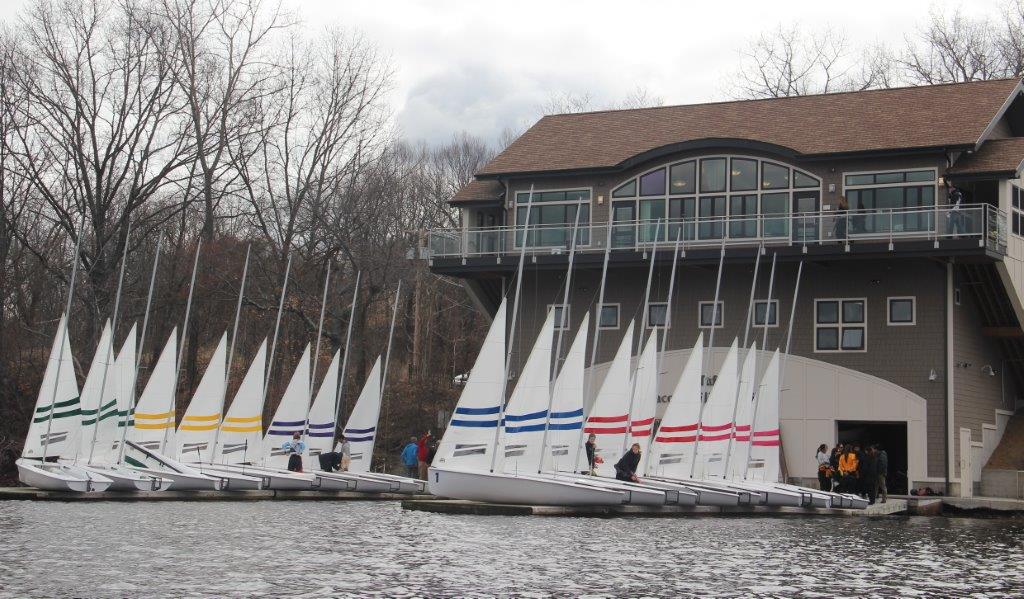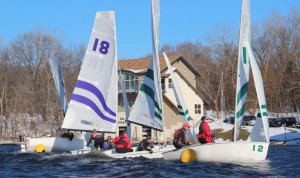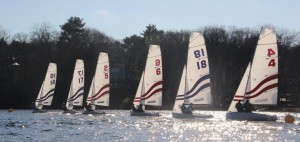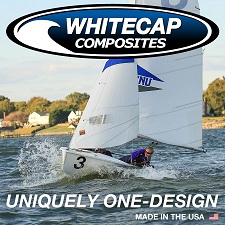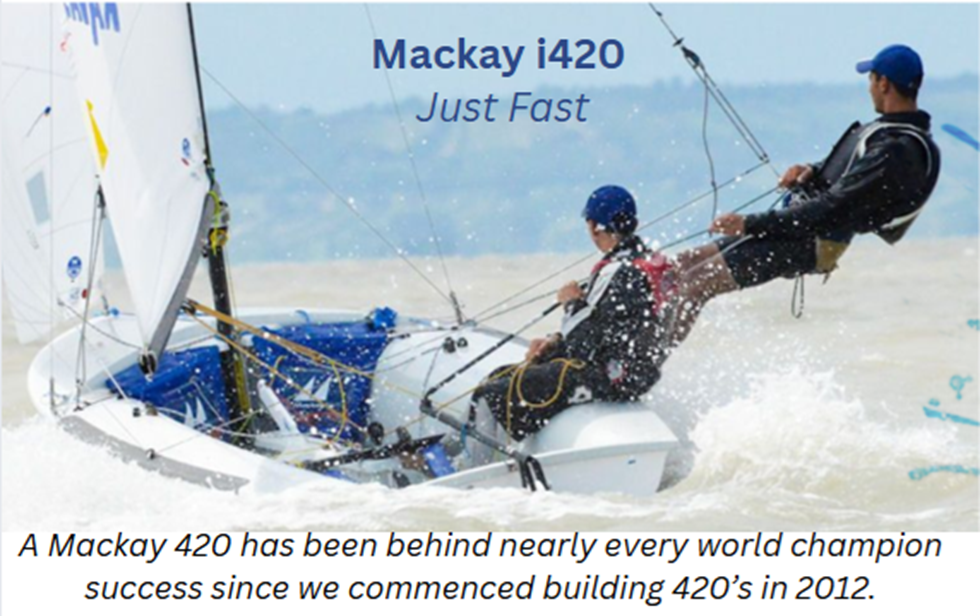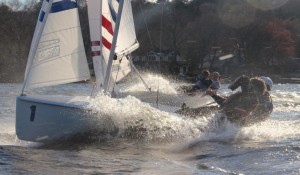
Hulls and decks were hand made with expert craftsman, are resin infused and bonded to a Soric core. The result is a lighter, stiffer, more consistent structure for simply a better boat. Doyle Sailmakers in Swampscott, MA also hand craft locally matching or even improving upon the long lasting sails they made back in 2010. The enormous “fat-head” mainsail powers up the boat as a spinnaker would downwind but twists off in big breeze upwind for any weight combination. The jibs were increased in area as well. Selden Spars of Charleston SC, provided tapered aluminum kappa section masts for power and weight saving along with ultra-light carbon booms.
Unique to college sailing features on these Turbo Larks include boom vang and Cunningham controls led back to both sides in between skipper and crew. Rudders are cassette style and centerboards are now composite, unlike the old plate aluminum boards of the past. The best feature of all might be the hull design which has passed the test of time since 1967. The deep “V” bow and narrow waterline allows for phenomenal light air upwind speed and feel. The flare to the rail puts hiking power where it belongs, outboard, allowing skipper and crew to keep far more power than they could on a narrower boat.
Tufts is home to some dozen college regatta per year and has been chosen host site for the 2017 Fowle Trophy Regatta for the New England Intercollegiate racing championship next April. This May some 48 alumni teams will take part in a massive Tufts Alumni regatta.
Lark sailboat
Back to the Future? A Look at the Lark Dinghy
By Rachael Silverstein
Since the first inter-collegiate dinghy fleet race in 1930, small boats and fast racing have become a healthy addiction for young sailors across the country. In 1934, Princeton developed the Tiger dinghy, which expanded college racing along the east coast. More recently, schools have tried the Vanguard 15, Tech Dinghy, Firefly, and Lark as their chosen double-handed boat, but the Club 420 and Club FJ have taken over the scene. A wide array of classes has been tried and tested through the generations of college sailors and many will follow, but some teams have held onto their boats and don’t intend to let go.
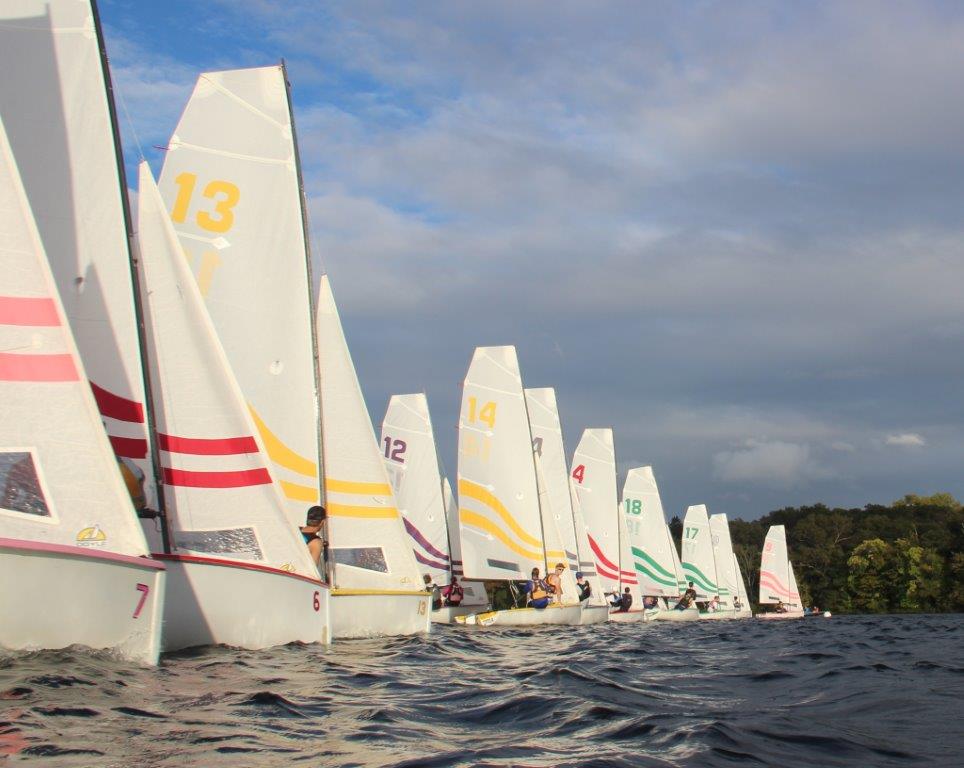
In 1972, Tufts traded in the Wee Nips, a single-sail vessel similar to Tech Dinghies, for a fleet of Larks, and hasn’t looked back. The team has sailed through five fleets of Larks, and is making room for their sixth by Spring 2016. Larks, primarily built in England, were more difficult to purchase and maintain than their mainstream counterparts—420’s and FJ’s. For their new fleet, the Jumbos teamed up with Whitecap Composites of Peabody, MA to undertake Lark construction with a more “institutional use in mind.” Legler works closely with Whitecap on a design to “improve durability and make repairs easier.”

When the sailors are practicing at home, Larks keep the sailing on Mystic Lake exciting.“The boats have an incredible feel to the helm and to the acceleration,” Legler describes, “the deep and narrow blades allow for instant sharp turns for team racing and other tactics. The light rig allows for dynamic mast movement for even faster maneuvers.” Racing doesn’t slow down when the wind lightens up, either. “Larks are very easily driven in light air due to the long, narrow waterline allowing good racing in winds as low as one knot, which is not the case in club dinghies,” he admits. The boats can sail as fast as the wind in up to six knots and plane as easily as a Laser, making it an ideal boat for sailing on Mystic Lake.
Whether the Lark will catch on as a popular college dinghy is uncertain, but they are waiting for willing sailors at the Bacow Sailing Pavilion. Legler labels this class as boats that “are rewarding when sailed well and unforgiving when not sailed well.” He believes that college sailing should be done for love of the sport, and provides his sailors with a fleet that is fun and challenging to sail. The way Coach Ken Legler sees it, “if college sailing is part of the education and part of the whole college experience for student sailors, then there is no better boat to enjoy the aesthetics, the healthy outdoor exercise, the camaraderie, and the challenges of friendly competition.”
Whitecap Composites: New Kids on the Block
Sail1Design would like to welcome our newest team member and sponsor, Whitecap Composites!
By Airwaves Writer Tyler Colvin
On a grey New England day I pulled around the corner of yet another non-descript warehouse building to discover a rack of hulls and plugs and an assortment of familiar bumper stickers. I had arrived at Whitecap Composites, in Peabody, Massachusetts, for a tour and to see what these guys were all about. Partners Ben Parker and Paul Zimmerman have created buzz about their little shop in recent years with their ability to turn out extremely high quality, durable boats for organizations and individuals.
Stepping through the door I was greeted by the familiar fiberglass and resin smell of a boat shop, reggaeton cutting through the hum of a pump and buzz of grinders. Ben came out to meet me with a smile and a handshake, very excited to show someone their operation. We walked through the assembly area, which consisted of boats in several stages of completion, and he explained the process that makes them unique from the slew of dinghy shops in the Northeast. “We take large boat construction and apply it to the dinghy. These are built like a real boat,” explained Ben, “everything about the construction process is repeatable and consistent.”
What Ben was referring to is the construction process they have been using since their shop opened back in 2011. In dinghy construction, there is usually a trade off between weight and durability. Fiberglass is laid up with resin by hand, cured, popped from the mold and put together. Not at Whitecap. Using structural fiberglass around a thin foam core combined with a vacuum bag infusion of resin, they are able to balance weight and stiffness, and are ensured a consistent product and create a bulletproof hull.
“Would you ever take a sledgehammer to one of your boats?” asked Ben, “well you can take one to ours.” He proceeded to tell me a recent story of some Kings Point guys who came up to see the shop and process, were asked the same question and then given a sledgehammer to test it out. Long story short, the sledgehammer lost.
The amount of pride that Ben and Paul put in their work is very apparent from their enthusiasm about the fleets they are building, new projects coming in to them and the thought of expanding. “We are unique in that we are responsive. We are available to our customers,” said Paul. “You see him and I? He is production, I am sales. If someone needs to ask a question on the phone, I cover the mouthpiece and ask him. Eliminates the need to go from department to department.”
Whitecap Composites has worked in conjunction with several college teams, one-design classes and individuals in the past four years. They have built 75 boats that are sitting on MIT’s docks, including the new Turbo FJ, which were purchased by both MIT and Northeastern University. Other schools are ordering from Whitecap as well, recently Christopher Newport University took delivery of 18 Turbo 420s. Eckerd is awaiting a shipment of FJs and 420s from Whitecap and Tufts has a new fleet of Larks in the works as well. Outside the college world they have also produced several other boats on a sub-contract basis, including the custom wakeless coach boats for Community Rowing in Boston and are working with the Comet class to revitalize.
Ben and Paul pride themselves on quality and the ability to accommodate their clients. “Our boats don’t come off the water during your season,” Ben commented, “we value quality over quantity.” Whether it is for a collegiate fleet or a custom build, they want you to feel involved in the process and help you get exactly what you want.
We would like again to give Whitecap Composites a warm welcome to the Sail1Design family as our newest team member. Feel free to stop over to their shop in Peabody to check them out, or just call Ben or Paul, they are sitting ten feet from each other, so if one doesn’t know the answer to your question, chances are the other does.
